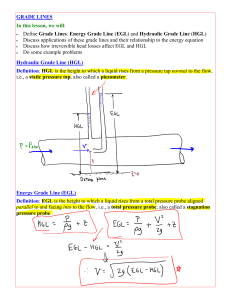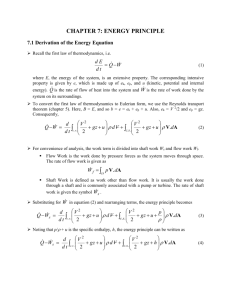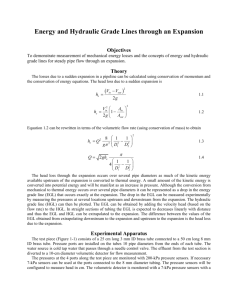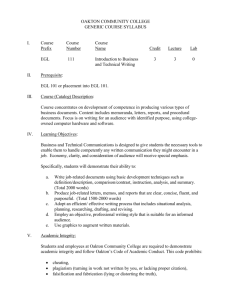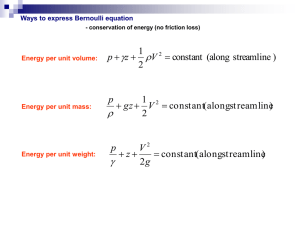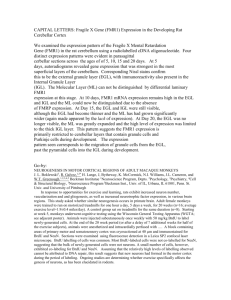CE319F Elementary Fluid Mechanics
advertisement
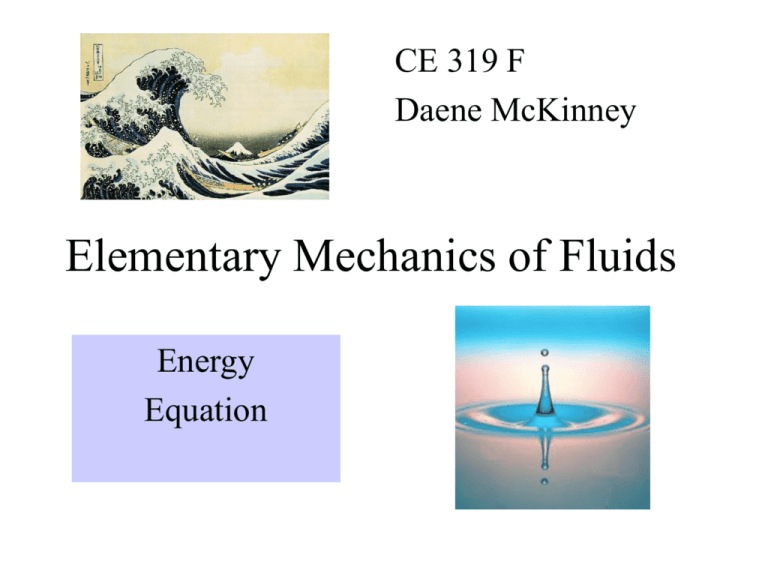
CE 319 F Daene McKinney Elementary Mechanics of Fluids Energy Equation Energy • First Law of Thermodynamics – Where • • • – Where • • • – E = energy of a system (extensive property) Q = Heat added to the system W = Work done by the system Eu = Internal energy of the system Ek = Kinetic energy of the system Ep = Potential energy of the system Intensive property (energy per unit mass) dE dQ dW dt dt dt Energy of a system changes as heat is added to the system or work is done on the system E Eu Ek E p e u ek e p Energy • Kinetic energy per unit mass kineticenergy of mass MV 2 / 2 V 2 ek mass M 2 • Potential energy per unit mass ep potentialenergy of mass z gz mass Energy Equation • Reynolds Transport Theorem d bd bV dA dt dt CV CS dBsys • b = e ; Bsys = E dE d ed eV dA dt dt CV CS dQ dW d ( ek e p u ) d ( ek e p u ) V dA dt dt dt CV CS Work • Rate of Work • Shaft work • • Flow work Viscous work dW dW dW dW dt dt shaft dt flow dt viscous dW dt dW dt dW dt work done by a mechanical device which crosses the CS shaft work done by pressure forces on the CS flow work done by viscous stresses at the CS viscous Flow Work • Work occurs at the CS when a force associated with the normal stress of the fluid acts over a distance. The normal stress equals the negative of the fluid pressure. dW p1V1 A1 dt 1 W2 p2 A2 l2 p2 A2V2 t dW p2 A2V2 p2 V2 A 2 dt 2 dW p pV A V dA dt flow CS CS Energy Equation dQ dW dt dt shaft d V2 p V2 gz u ) V dA ( gz u ) d ( dt CV 2 2 CS Kinetic Energy Correction Factor dQ dW d V2 p V2 ( gz u ) d ( gz u ) V dA dt dt shaft dt CV 2 2 CS V2 ( gz u ) V A V dA 2 CS CS p We can modify this kinetic energy term by a dimensionless factor, , so that the integral is proportional to the square of the average velocity 1 V dA AA where V and 1 V dA A A V For nonuniform flows, this term requires special attention V2 V2 V dA m 2 2 CS m V A V1 A1 V2 A2 3 so Kinetic energy correction factor V12 p1 V22 p2 q wshaft 1 gz1 u1 2 gz2 u2 2 2 q 1 dQ ; m dt wshaft 1 dW m dt shaft Energy Equation for Pipe Flow V12 p1 V22 p2 q wshaft 1 gz1 u1 2 gz2 u2 2 2 wshaft wturbine w pump V12 p1 V22 p2 1 gz1 w pump 2 gz2 wturbine (u2 u1 q) 2 2 V12 p1 V22 p2 1 z1 h pump hturbine hloss 2 z2 2g 2g h pump w pump g w ; hturbine turbine ; g u u q hloss 2 1 g Ex (7.35) • Given: PA= 10 psi (12 in dia. pipe), PB= 40 psi (6 in dia. pipe), Q=3.92 cfs Find: Horsepower of pump Solution: • • V A2 p A VB2 p B A z A h pump hturbine hloss B zB 2g 2g h pump VB2 2g ( 4.99) (6.19) 2 V A2 pB p A 2 (10 40) *144 62.4 2g 75.04 ft Qh 3.92 * 62.4 * 75.04 P 33.4 hp 550 550 VA VB Q AA Q AB 3.92 (1) 2 / 4 4.99 ft / s; 3.92 (0.5) / 4 2 19.96 ft / s EGL & HGL for a Pipe System • Energy equation V12 p1 V22 p2 1 z1 hL 2 z2 2g 2g • • All terms are in dimension of length (head, or energy per unit weight) HGL – Hydraulic Grade Line HGL • p EGL – Energy Grade Line EGL • • z V2 p V2 z HGL 2g 2g EGL=HGL when V=0 (reservoir surface, etc.) EGL slopes in the direction of flow EGL & HGL for a Pipe System • A pump causes an abrupt rise in EGL (and HGL) since energy is introduced here EGL & HGL for a Pipe System • A turbine causes an abrupt drop in EGL (and HGL) as energy is taken out • Gradual expansion increases turbine efficiency EGL & HGL for a Pipe System • • When the flow passage changes diameter, the velocity changes so that the distance between the EGL and HGL changes When the pressure becomes 0, the HGL coincides with the system EGL & HGL for a Pipe System • Abrupt expansion into reservoir causes a complete loss of kinetic energy there EGL & HGL for a Pipe System • When HGL falls below the pipe the pressure is below atmospheric pressure HW (7.8) HW (7.16) HW (7.27) HW (7.27) HW (7.41)


